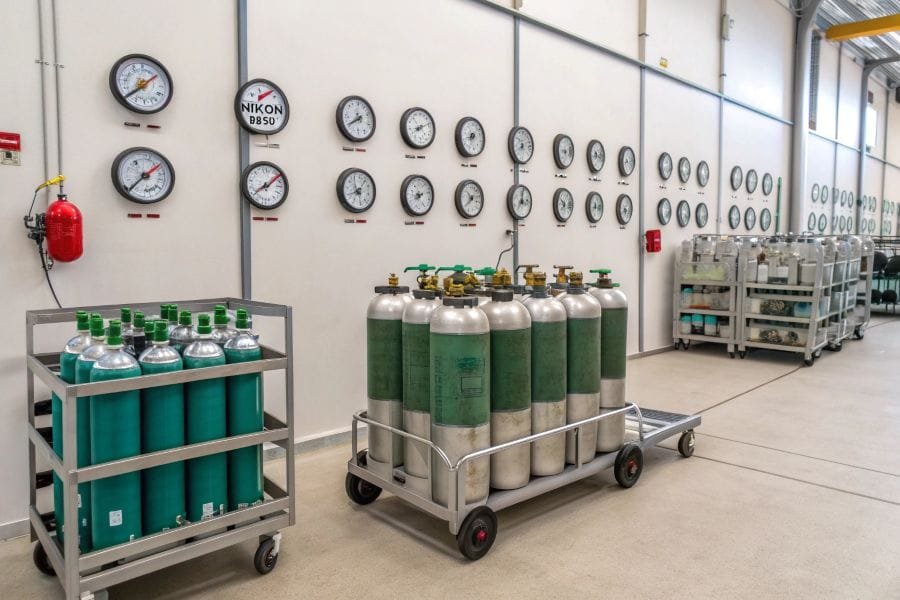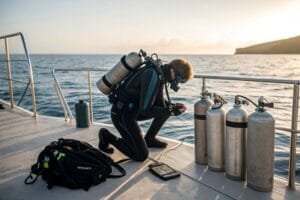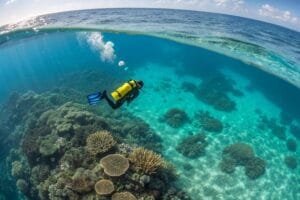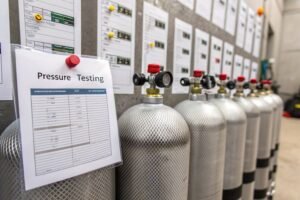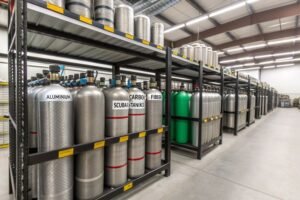Making your own scuba tank seems like a money-saving idea. You want reliable gear for diving adventures. But the reality might shock you.
Building a scuba tank at home is extremely dangerous and illegal in most places. Professional manufacturers use specialized equipment, strict quality controls, and safety certifications that home builders cannot achieve. Always buy certified tanks from reputable manufacturers.
I get it. You see the price tags on quality diving equipment and think there must be a cheaper way. After working with dive shops across Australia and the US for over a decade, I've seen too many accidents from people cutting corners on safety equipment. Let me walk you through why this path leads to serious problems and show you better alternatives.
Can you use a regular air compressor to fill a scuba tank?
You look at your garage compressor and wonder if it can handle scuba tank filling. The pressure ratings seem similar on paper. But appearances fool you here.
Regular air compressors cannot safely fill scuba tanks. They lack the pressure capacity, proper filtration systems, and breathing-air quality controls required for underwater breathing apparatus. Only certified dive compressors should fill scuba tanks.
Why Regular Compressors Fall Short
Most garage compressors max out at 150-200 PSI. Scuba tanks need 2,200-4,500 PSI depending on the type. That's like comparing a garden hose to a fire truck's water cannon.
But pressure isn't the only problem. Regular compressors pull air from wherever they sit. Your garage air contains:
- Motor oil particles from cars
- Dust and debris
- Carbon monoxide from vehicles
- Moisture that causes tank corrosion
- Industrial pollutants
| Compressor Type | Max Pressure | Air Quality | Breathing Safe |
|---|---|---|---|
| Home Workshop | 150-200 PSI | Unfiltered | No |
| Dive Shop | 3,000-4,500 PSI | Medical Grade | Yes |
| Industrial | 500-1,000 PSI | Basic Filter | No |
Dive compressors cost $15,000-50,000 because they include multiple filtration stages. They remove carbon monoxide, oil vapors, and moisture. They also test air quality every few hours during operation.
I've seen divers get carbon monoxide poisoning from poorly filled tanks. One customer in Sydney ended up in the hospital after using a tank filled by an uncertified shop. The medical bills exceeded $20,000.
Is a scuba tank 100% oxygen?
You might think more oxygen means better diving performance. This common mistake sends people to emergency rooms every year. Pure oxygen becomes toxic underwater.
Scuba tanks typically contain compressed air (21% oxygen, 78% nitrogen) or enriched air nitrox (22-40% oxygen). Pure oxygen tanks exist only for specialized surface decompression and should never be used for recreational diving below 20 feet.
Understanding Gas Mixtures in Diving
Regular scuba tanks hold the same air you breathe on the surface, just compressed. At sea level, this works perfectly. But underwater pressure changes everything.
Oxygen becomes toxic at partial pressures above 1.4 ATA. With pure oxygen, this happens at just 13 feet underwater. Oxygen toxicity causes:
- Sudden seizures without warning
- Loss of consciousness
- Drowning in most cases
Nitrox tanks contain enriched oxygen (22-40%) for longer bottom times and faster decompression. But even these require special training and depth limits.
| Gas Mix | Oxygen % | Max Safe Depth | Training Required |
|---|---|---|---|
| Air | 21% | 130+ feet | Open Water |
| Nitrox 32 | 32% | 95 feet | Nitrox Certified |
| Nitrox 36 | 36% | 84 feet | Nitrox Certified |
| Pure O2 | 100% | 20 feet surface only | Technical Diving |
I remember a customer from Texas who bought pure oxygen tanks thinking they were regular air. His dive computer showed oxygen toxicity warnings at 25 feet. Fortunately, his buddy recognized the symptoms and got him to the surface quickly.
Technical divers do use pure oxygen, but only for decompression stops at 20 feet or shallower. They carry multiple gas mixtures and switch between them at specific depths.
What materials are scuba tanks made of?
You need to understand tank materials before considering any tank purchase. Different materials serve different diving needs and budgets. The wrong choice affects your diving safety and wallet.
Scuba tanks are primarily made from aluminum alloy or steel, with carbon fiber composite tanks for specialized applications. Aluminum tanks are lighter and corrosion-resistant. Steel tanks are smaller and hold more air. Carbon fiber tanks are lightest but most expensive.
Aluminum Scuba Tanks
Aluminum tanks dominate recreational diving. They use 6061-T6 aluminum alloy, the same grade used in aircraft construction. This material offers excellent corrosion resistance in saltwater environments.
Manufacturing starts with seamless aluminum cylinders. We heat-treat them to achieve proper strength, then machine the valve threads and apply protective coatings. Each tank undergoes hydrostatic testing at 5/3 times working pressure.
Aluminum tanks have some drawbacks. They become positively buoyant when half-empty, making buoyancy control trickier at the end of dives. They're also larger than steel tanks with equivalent air capacity.
Steel Scuba Tanks
Steel tanks use chromium-molybdenum alloy steel for superior strength. This allows thinner walls and more compact designs. A steel AL80-equivalent tank is notably smaller and holds more air.
The manufacturing process involves hot-forming steel into seamless cylinders, then heat-treating for optimal strength. We apply zinc galvanizing inside and protective paint outside to prevent rust.
Steel tanks stay neutrally buoyant throughout the dive, improving underwater trim. But they require more careful maintenance to prevent internal corrosion, especially in humid climates.
| Material | Weight (empty) | Buoyancy | Corrosion Resistance | Price Range |
|---|---|---|---|---|
| Aluminum | 14-17 lbs | Positive when low | Excellent | $150-300 |
| Steel | 16-20 lbs | Neutral throughout | Good with care | $200-400 |
| Carbon Fiber | 7-9 lbs | Negative | Excellent | $800-1500 |
Carbon Fiber Composite Tanks
Carbon fiber tanks represent the latest technology. They use aluminum or steel liners wrapped in carbon fiber and resin. This creates incredibly light tanks with excellent strength-to-weight ratios.
These tanks cost significantly more but offer major advantages for travel diving and technical applications. They're about half the weight of aluminum tanks with similar capacity.
Manufacturing involves precision winding of carbon fiber filaments around a metal liner. The process requires specialized equipment and quality control that explains the higher cost.
I've shipped carbon fiber tanks to technical divers in the Middle East who needed maximum air capacity with minimum weight for cave diving expeditions. The weight savings allowed them to carry additional safety equipment.
However, carbon fiber tanks need careful handling. They can be damaged by impacts that wouldn't affect aluminum tanks. They also require specialized repair facilities if damaged.
Conclusion
Making your own scuba tank is dangerous and illegal. Buy certified equipment from reputable manufacturers to protect your life underwater.

